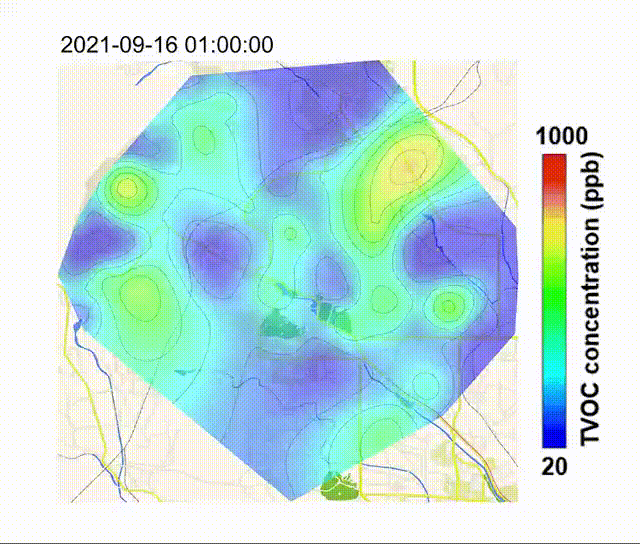Recently, Professor Jiang Jingkun’s research group at the Division of Air Pollution and Control of the School of Environment, Tsinghua University, has made new progress in the field of high-density grid monitoring of volatile organic compounds (VOCs). The group has developed a low-cost total volatile organic compound (TVOC) monitor based on electrochemical sensor array technology and deployed it for establishing high-density monitoring network in an area of approximately 55 square kilometers. This online monitoring network, with high spatial and temporal resolution, captures the emission characteristics of VOCs and promotes the application of sensor technology in atmospheric environmental monitoring.
VOCs, as a typical kind of the air pollutants, are generated from a variety of artificial sources. The abundance and spatial distribution of easily diffusible VOCs are affected by factors of emission rate, pollution source distribution, and meteorological conditions, with significant spatiotemporal variability, which pose challenges to effective VOC regulation. Therefore, it is crucial for source identification and abatement of atmospheric VOCs via regional high-density monitoring of VOCs.
In recent years, Professor Jiang Jingkun’s research group has made progresses in addressing the sensitivity, selectivity, and stability of sensors, and collaborated with several organizations to develop sensors such as toluene sensors (Journal of Hazardous Materials, 2021, 125034), formaldehyde sensors (Advanced Materials, 2022, 2105276), and hydrogen peroxide sensors (Small, 2020, 1902860; Environmental Science: Nano, 2022, 9:1759).
Built upon previous progresses, the group proposed a TVOC monitor based on electrochemical sensor array technology, which was designed to detect typical and interfering compounds in VOCs. Before installation, they were also checked for consistency and long-term stability compared with gas chromatography-mass spectrometry (GC-MS). Environmental monitoring results show that the sensor array’s response has good consistency in the dynamic trend with GC-MS test data (average absolute percentage error and R2 were 46.0±3.0% and 0.74±0.01, respectively).

Figure 1 Atmospheric TVOC monitoring network based on electrochemical sensor array technology

Figure 2 Dynamic monitoring results of atmospheric TVOC monitoring network
Sensor arrays were used for atmospheric TVOC monitoring network. The research group set up a network contained 152 sets of TVOC monitors in a mixed-use land area (such as industrial areas, residential areas, and urban roads) of approximately 55 square kilometers. The monitoring results can accurately and timely describe the spatiotemporal characteristics of local TVOC concentrations, identify VOC emission sources, and guide emission abatement. In addition, types of pollution sources can also be clarified by joint vehicle-mounted GC-MS detecting results, which verify the results of the TVOC monitoring network.

Figure 3 Comparison of joint observation results between the TVOC monitoring network and vehicle-mounted GC-MS
Therefore, large-scale, low-cost, and high-density TVOC monitoring network can accurately and intuitively describe pollution sources and their diffusion trends, bridging the gap between existing VOC simulation studies and actual situations and reducing blind spots in environmental monitoring. It is of great significance for accurately tracing pollution sources and promoting the sustainable upgrading of industries.
On September 17, 2022, the above research results were published online in the journal Science of the Total Environment entitled “High-density volatile organic compound monitoring network for identifying pollution sources”. Tsinghua University Ph.D. graduates Li Zehui (Currently an Associate Research Professor at Peking University) and Ma Zizhen (Currently an Associate Professor at Qingdao University of Technology) are the co-first authors of the paper, while Professor Jiang Jingkun of Tsinghua University, Professor Liu Kaihui and Associate Research Professor Li Zehui of Peking University are the co-corresponding authors. Collaborating institutions include Beijing Capital Air Environment Technology Limited Company, TC Air Technology Limited Company, Qingdao Institute of Bioenergy and Bioprocess Technology, Chinese Academy of Sciences, and University of Science and Technology Beijing.
Paper link: https://www.sciencedirect.com/science/article/abs/pii/S004896972205971X





